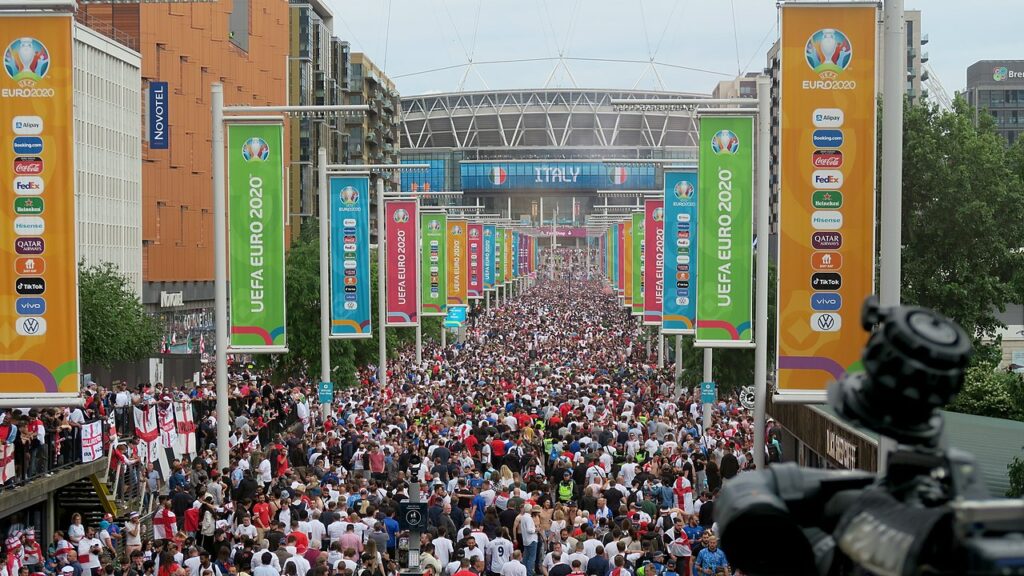23.06.2022
Digitalisation in the sports and event sector: What Flensburg and Wembley Stadium have in common.

London, Wembely Stadium. Seating rows with a total length of 54 kilometers. 688 snack and drink outlets. 47 fan shops. 2,618 toilets. 8 restaurants. The population of a large medium-sized German city such as Flensburg regularly moves through this mammoth building to experience a Three Lions international match, an Adele concert or another event live.
Logistical challenges for all involved
In Europe alone there are almost 80 sports stadiums with a capacity of more than 50,000 visitors, and the situation is likely to be similar in all of them for a major event. In most cases, the doors open 90 minutes before the start of the event. There is little time for 50,000+ people to relax and find their way to their booked seats, get a cool drink or stop by the fan shop.
Instead of relaxed anticipation, there is often stress and a hectic pace, which is a reason for quite a few people to avoid such events, even though they would like to visit. At the same time, it is essential for stadium operators to keep the capacity utilization of the events taking place as high as possible in order to operate profitably.
So, what can be done to reduce the negative stress, make the positive fan experience perfect and convince visitors to leave the comfort of their couch at home in favor of an on-site visit? As always, the magic word here is “digitalisation”, which – to put it bluntly – is used to slay any problem these days.
Indoor navigation via smartphone
And the starting point could not be simpler. Many arena operators and football clubs already provide their fans and visitors with iOS and Android smartphone apps that contain all the important information about the club or the venue. A so-called SDK (Software Development Kit) can be integrated into these apps with manageable effort, making indoor navigation via Bluetooth possible. The basis for this is an infrastructure of permanently installed Bluetooth Low Energy Beacons, which form the reference points for turn-by-turn navigation inside the stadium with an accuracy of around 3-5 meters.
In addition to the blocks, any location (snack point, fan shop, toilet, lift, escalator, etc.) in the stadium can also be stored as a point of interest (POI). This means that visitors can not only be conveniently navigated to their block via indoor navigation, but also to any other desired POI. In principle, this is similar to navigation via GPS, which, as is well known, does not work inside large building structures.
Opening new up selling and marketing potentials
Of course, the common season ticket holder of a Bundesliga football club will now say: “What’s the point of this nonsense, I know where my seat is, I’ll find it without an indoor navigation system.” But firstly, event visitors are often not repeat visitors, but rather unfamiliar with the venue. In this case, a detailed digital interactive arena map can certainly put them in a good mood and – ideally – also encourage a second or third visit.
The best example of the potential offered by indoor navigation in stadiums are major events such as football World Cups or European Championships. Here, huge numbers of fans from all over the world have to find their way around stadiums that are mostly unknown to them.
Secondly, a proximity function can also be integrated into fan apps via the built-in Bluetooth infrastructure, which – provided the app user has given location and message approval – can trigger a push message when a certain POI is approached. This can be location-, time- or rule-based and contain, for example, information about the latest merchandising offers or discount codes for shops or snack points or alert the user to fan promotions that are currently taking place in their vicinity in the stadium circuit. The app thus becomes a live communication tool that makes the visitor/fan feel good and, incidentally, offers the provider high up selling and marketing potential.
A win-win situation for both sides. Clubs or arena operators who can realize an infinite number of marketing activities with little effort and relaxed, well-informed visitors who experience the perfect day in the stadium. However, where even the most precise indoor navigation will fail: to guide the ball into the (from the fans’ point of view) right goal. So, despite all the digital tricks, the game remains thrilling 😉.
Photo Credit: Credit: Kwh1050, CC BY-SA 4.0 https://creativecommons.org/licenses/by-sa/4.0, via Wikimedia Commons